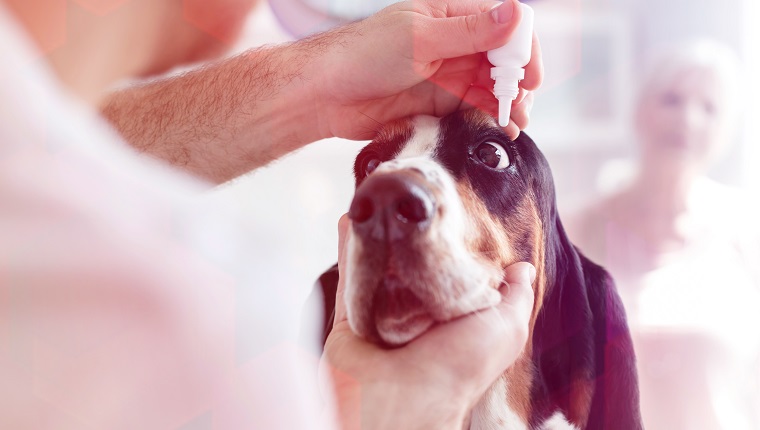Dry eye in dogs is a condition in which the cornea and the surrounding parts of the eye become inflamed, often due to a lack of tear film. The medical name for the condition is Keratoconjunctivitis Sicca, or KCS.
There are many different reasons, some mild, others more severe, as to why your dog might suffer from dry eye. More often than not, your veterinarian will prescribed medicated drops or simple lubrication drops, especially if you have a dog breed prone to the condition.
Still, as some of the underlying conditions can be serious, you must contact your veterinarian and find a course of treatment as soon as you notice anything out of the ordinary in your dog’s eye or eyes.
Here’s what you should know about the symptoms, causes, and treatments for dry eye in dogs.
Symptoms Of Dry Eye In Dogs
Symptoms of dry eye in dogs mostly relate to eye distress. Your dog might paw at their eye or have inflammation around it. If the issue bothers them enough, some dogs might also lose interest in activities or prefer to sleep and keep the eye shut.
Here are some of the symptoms that might appear in dogs who suffer from dry eye:
- Red eyes
- Thick discharge from the eyes
- Pawing of the eyes or eye area
- Sensitivity to bright light
- Secondary corneal ulceration
- Secondary bacterial conjunctivitis
Causes Of Dry Eye In Dogs

There are many common reasons dogs get dry eye. There’s likely a genetic element, as certain breeds, like the Cavalier King Charles Spaniel, West Highland Terrier, English Cocker Spaniel, the Pug, and other flat-faced breeds are more prone to developing the condition.
Autoimmune issues can also cause immune-mediated reaction of the lacrimal glands, or shut down the glands that produce tears. Long-term medication, particularly antibiotics, has also been connected to dry eye in dogs.
Here are several possible causes:
- Breed predisposition
- Long-term antibiotic treatment
- Naturally smaller tear glands
- Physical trauma to the eye area and tear glands
- Autoimmune issues
Treatment For Dry Eye In Dogs
Treating your dog’s dry eye depends on the underlying cause, which your veterinarian can determine. For many dogs, KCS is a lifelong issue, and your vet may recommend lubricating drops to administer daily.
If a secondary infection has occurred, your vet may prescribe medicated lubricating drops. Even though giving your dog eye drops can sometimes be a pain, it’s important to administer them as advised by your vet.
If a dog’s dry eye is so severe that it continuously causes secondary infections, your vet may recommend a surgical procedure called “parotid duct transposition,” which takes a duct from the mouth that produces saliva and places it in the tear duct area.
Does your dog suffer from dry eye? What treatment are you using to keep your dog comfy and healthy? Let us know how you’re treating your dog’s KCS in the comments below!





